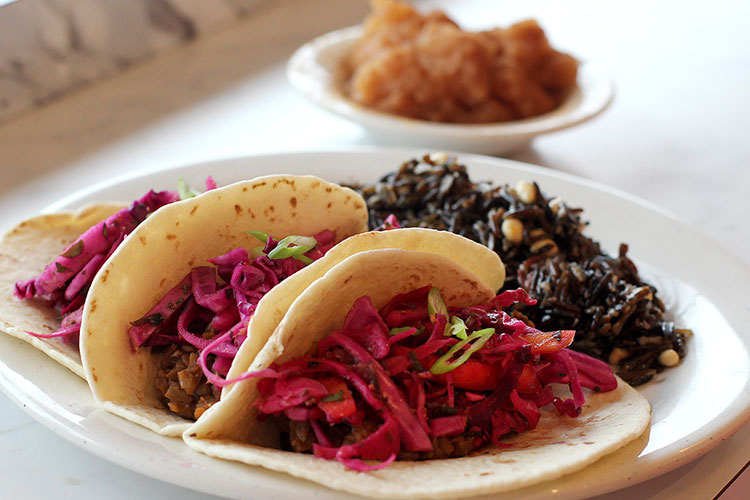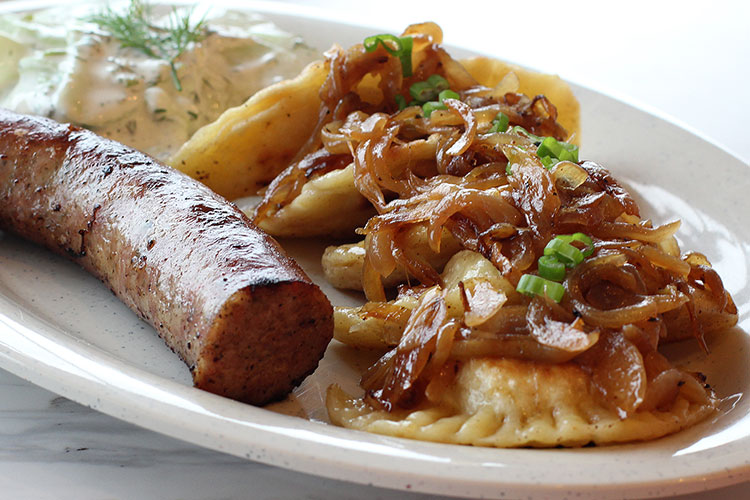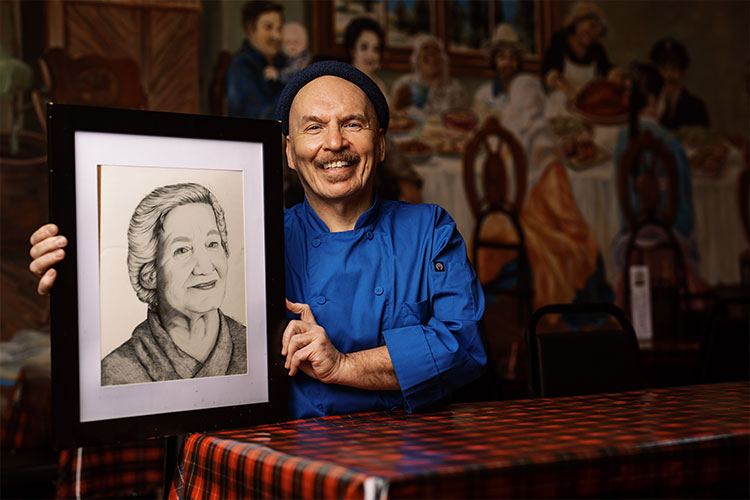
Jozef Zebediah of My Grandmother’s Table
A Seat at the Table
From Polish dishes and Thai chicken to a one-hundred-year-old cake recipe from New Orleans, diners can experience the flavors of the world at Jozef Zebediah’s restaurant, My Grandmother’s Table
Jozef Zebediah, or Joe for short, is a graduate of Columbia University and a licensed psychotherapist, ordained interfaith minister, relationship and creativity coach, author, performance artist and chef-baker.
While he’s always held a deep and abiding connection to New York City, ever since moving to Northern Michigan to be with his now-spouse Nick, the area has become his home.
“There's no other place I'd rather be,” he says. “The natural beauty of Michigan, in general, and the Great Lakes in particular, often leave me without words. I simply love it here and have never felt more fortunate, or more at home, than I do today.”
As chef-owner of My Grandmother’s Table – named in honor of his grandmother Martha – Joe shares the philosophy behind his restaurant and how he infuses love and authenticity into everything he cooks.
“I lived in New York City most of my life, on West 13th Street between Seventh and Broadway in Manhattan. In New York, you’re surrounded by people from all around the world: every religion, every profession, every demographic, every kind of person. I grew up seeing that kind of diversity in the city, but I also grew up seeing that in my own home.
At my grandmother’s dinner table, there would be all kinds of people sitting down for a meal: a sex worker would sit next to a priest who would sit next to a police officer. But it wasn’t until I got into middle school that I realized that the joy that came from having such an inclusive table wasn’t the way it was out in the rest of the world.
I never planned on opening a restaurant. Although I grew up in the restaurant industry and went to three different culinary schools, that was all for the joy of it and opening a business was never on my radar. I was a professional actor into my 30s. Then I became a psychologist. Then I became a professor. Then I became an interfaith Minister.
All of that seems random, but the thread for me was empathy, really relating to people, and using myself in that way. When I moved to Northern Michigan to live with my spouse Nick, my then-partner, I decided I didn’t want to try and build a psychology practice from scratch.
Thinking back to my experience growing up in New York City, and seeing all those kinds of people and all those different kinds of food at my grandmother’s table, I thought, ‘Why not put food front and center, here?'

While I was getting a license to do farmers markets, people started saying stuff like, ‘You know, Joe, this is not New York. You're a Michigander now and Michiganders are not into ethnic foods. We don't want to burst your bubble or anything, but maybe you should know.’ And I thought that was kind of crazy.
So, I go to the first farmers market thinking it might be my last one, who knows? And it really was the exact opposite: people were interested in trying ethnic foods. Even more touching for me were the people who came up and said, ‘I hear you make OUR food.’ It was the most spectacular thing. That’s something that happens here on a regular basis. Whether it's Native Americans, people from India, people from Poland, or people from Asia. People are really, truly coming here and then bringing their friends once they've tried it. It’s a way for us to say, ‘I see you.’ That's been the most inspiring thing.

It's a global menu, made from scratch. Recently, we were getting ready to do a TV interview and they said to me, ‘We want to see you do three items, from beginning to end.’ And I told them they would be here for six hours, because that's how long it takes sometimes to do one thing.
We want to introduce people to foods, not only from around the world, but from around the United States as well. For example, we just introduced our Sioux City sloppy joe. We added it to the menu because I found someone who was related to the cook named Joe, who in Sioux City in 1925, created it, and we use his recipe. I even found documentation to support that — we’re all about authenticity and that is as authentic as you can get. We have breakfast, depending on the time of year. We have a Santa Fe breakfast burrito. We have Israeli French toast. We have North African halva, which is like a pumpkin and oatmeal dish.
 For entrees, our most popular entree are actually the two Polish dishes: stuffed cabbage and pierogies. But next would be Thai orange peanut chicken. For baked goods, on any given day, we could have Amish ginger molasses cookies, Italian wedding cake, German apple spice cake, all different types of desserts from around the world. We got our chocolate cake recipe from New Orleans and it’s over 100 years old. Many of those bakeries spent a lot of time developing the perfect vanilla cake and chocolate cake. Hours and hours spent on the perfect recipe. Someone told me about this chocolate cake recipe, I tried it and it became a hit.
For entrees, our most popular entree are actually the two Polish dishes: stuffed cabbage and pierogies. But next would be Thai orange peanut chicken. For baked goods, on any given day, we could have Amish ginger molasses cookies, Italian wedding cake, German apple spice cake, all different types of desserts from around the world. We got our chocolate cake recipe from New Orleans and it’s over 100 years old. Many of those bakeries spent a lot of time developing the perfect vanilla cake and chocolate cake. Hours and hours spent on the perfect recipe. Someone told me about this chocolate cake recipe, I tried it and it became a hit.
When we’re looking for recipes, we want to make sure we can pinpoint them to a region and a story to tell. Like with our stuffed cabbage, that recipe came over on a boat from Poland in 1901. We want to stick to that original recipe because rather than being the Polish-American version of a recipe, we really want to represent the true nature of it. That’s what really excites me: to be able to tell the story of others who have created something a long time ago. We’re really standing on the legacy of work that was put in.
For me, there’s one word this restaurant is centered around, and that’s ‘nourish.’ When I think of my grandparents and what they did for the people who came into their home, even for the people who by society standards would be rejected. For example, my grandmother would put the mayor's wife next to a homeless man. She wouldn’t do that to be manipulative, but to give people an opportunity who had never been seen or heard before. Everyone has a story to tell, and she knew that.
She would say to me, ‘The food is second to the people, the conversations and the connections that happen. You can nourish by doing that as well.’ She also taught me that ingredients, no matter what ingredient it might be, are all gifts from nature. Whether that is beef from a cow, potatoes from the ground, it's a gift. Your job then, as a cook, is to take nature's gift and transform it into a gift for someone else.
When it came time for me to put all of this together on the farmers market application, the form said, ‘What’s the name of your business?’ I didn’t really have a name in mind. I thought about it, and ‘My Grandmother’s Table’ came to me. It was like electricity. My past and what I learned from my grandmother coalesced into what I’m trying to do with food. Not only in the food, but in the way people are treated when they come in. Whether it’s the murals, or the conversations, or the food, I want to give people the sense of ‘There’s a seat for you here, at my grandmother’s table.’’
This story originally appeared as a part of the Michigan Main Street Story Series.
